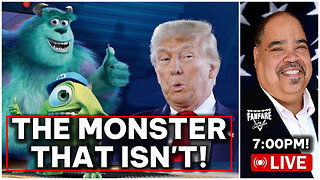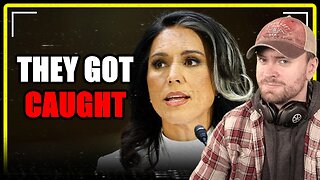Premium Only Content

Episode 2094: The Paradox of Authority: Lawlessness in Society and the Church
You know how I say “So goes the church so goes the society”
What we see today is lawlessness. We see crimes going on and yet it seems that law enforcement is doing little about it. Why?
Now let me compare that with something else. We see the godless behavior in the church and we see the church doing little about it. Why?
So what will happen if they don’t or better yet what happens if they take it upon themselves to do what they know is right and ignore the command of their superior. Well they are brought up on charges and cancelled.
So the question is why is this happening? Why are good men being silenced?
In contemporary society, the prevailing sentiment often revolves around a perceived sense of lawlessness. Crimes persist, seemingly unchecked by law enforcement, while within religious institutions, godless behaviors often go unaddressed by the church hierarchy. This episode will delve into this apparent paradox, drawing parallels between the roles of law enforcement officers and religious leaders, and examining the challenges they face in upholding their respective mandates.
Law Enforcement and Religious Authority:
At first glance, the roles of law enforcement officers and religious leaders may seem disparate, yet upon closer inspection, parallels emerge. Both are subject to hierarchical structures, with police officers answering to their superiors, just as priests answer to bishops or the Pope. This hierarchical framework instills a sense of duty and obedience, where directives from higher authorities are to be followed without question.
Consequences of Disobedience:
However, the obedience expected from law enforcement officers and religious leaders can present a dilemma when confronted with conflicting directives or perceived injustices. In both spheres, individuals who choose to act according to their conscience, disregarding commands from above, often face severe consequences. Whether it be disciplinary action within law enforcement or censure within the church, the risk of being "cancelled" looms large for those who dare to defy authority.
Silencing the Dissenters:
This raises the question: Why are good men and women silenced? Why does a culture persist where those who seek to do what they believe is right are met with punishment rather than praise? The answer lies in the complex interplay of power dynamics, institutional interests, and societal norms. Both law enforcement agencies and religious institutions are not immune to the influence of politics, bureaucracy, and self-preservation.
Challenges to Upholding Justice and Morality:
Moreover, the challenges faced by law enforcement and religious leaders extend beyond the confines of their respective organizations. In a world characterized by rapid social change and shifting moral landscapes, the lines between right and wrong become increasingly blurred. This ambiguity can paralyze decision-making processes, leading to inaction or misguided responses to pressing issues.
Let's delve deeper into the challenges faced by law enforcement and religious leaders in upholding justice and morality in today's rapidly evolving societal landscape.
Social Change and Moral Shifts: Society is in a constant state of flux, with evolving norms, values, and ethical standards. What was considered morally acceptable in the past may no longer hold true today. This creates a challenge for both law enforcement and religious leaders, as they must navigate these shifting moral landscapes while upholding the principles they are tasked with enforcing or promoting.
Cultural Pluralism and Diversity: In multicultural and diverse societies, there is often a clash of values and beliefs. Law enforcement officers and religious leaders may find themselves grappling with the challenge of balancing the needs and expectations of various cultural, ethnic, and religious communities. This can lead to tensions between different groups and complicate efforts to enforce laws or promote moral teachings that are universally accepted.
Technological Advancements: The rapid advancement of technology has revolutionized the way society operates, presenting both opportunities and challenges for law enforcement and religious institutions. On one hand, technology can be a powerful tool for crime prevention and detection, as well as for disseminating religious teachings. On the other hand, it also introduces new forms of crime and ethical dilemmas, such as cybercrime, online radicalization, and privacy concerns.
Political Interference and Corruption: Both law enforcement agencies and religious institutions are susceptible to political interference and corruption, which can undermine their ability to uphold justice and morality. Political agendas, lobbying, and vested interests may influence decision-making processes and hinder efforts to address pressing social issues or hold wrongdoers accountable.
Lack of Resources and Support: Law enforcement agencies and religious organizations often struggle with limited resources, whether it be financial, personnel, or infrastructure. This can impede their ability to effectively carry out their duties and respond to emerging challenges. Additionally, a lack of support from government authorities or within their own institutions can further exacerbate these challenges.
Public Perception and Trust: Maintaining public trust and confidence is essential for both law enforcement and religious leaders. However, incidents of misconduct, corruption, or scandal can erode trust and credibility, making it difficult to garner support for their initiatives or enforce moral standards. Rebuilding trust requires transparency, accountability, and a commitment to addressing wrongdoing within their ranks.
Legal and Ethical Dilemmas: Law enforcement officers and religious leaders often find themselves facing complex legal and ethical dilemmas in their day-to-day operations. Balancing the need for justice with compassion, the protection of individual rights with public safety, and the promotion of moral values with respect for diversity are just some of the challenges they encounter.
In navigating these challenges, law enforcement agencies and religious institutions must adapt to the changing realities of the world while remaining steadfast in their commitment to upholding justice and morality. This requires continuous dialogue, collaboration, and a willingness to confront difficult issues head-on, even in the face of resistance or adversity. Only by addressing these challenges proactively can they fulfill their respective roles as guardians of law and stewards of moral conscience in an ever-changing society.
How would Christ and the Saints dealt with this Paradox
Let's explore how Jesus Christ and the great saints might have approached the paradox of lawlessness in society and inertia within religious institutions, considering the challenges outlined earlier.
Christ's teachings and actions consistently emphasize the importance of standing up for truth, even in the face of opposition or persecution. While there may not be a direct statement from Christ advocating for priests to be "cancelled" for standing up for the faith and morals of the Church, his teachings and examples provide ample support for the principles of integrity, courage, and fidelity to God's truth.
Confrontation with Religious Leaders: Throughout the Gospels, Jesus confronts the religious leaders of his time, such as the Pharisees and Sadducees, for their hypocrisy and failure to uphold the true spirit of the law. He rebukes them for prioritizing human traditions over God's commandments and for leading people astray with their teachings (Matthew 23, Mark 7:1-23).
Persecution for the Sake of Righteousness: In his Sermon on the Mount, Jesus teaches, "Blessed are those who are persecuted for righteousness' sake, for theirs is the kingdom of heaven" (Matthew 5:10). This suggests that standing up for righteousness, even in the face of persecution, is commendable in the eyes of God.
The Example of Martyrs: The lives and writings of the early Christian martyrs, such as Saint Stephen, Saint Ignatius of Antioch, and Saint Polycarp, demonstrate a steadfast commitment to their faith and morals, even at the cost of their own lives. They chose to endure persecution and martyrdom rather than compromise their beliefs.
Defending the Faith: Throughout Church history, saints and theologians have defended the faith and morals of the Church against heresy, corruption, and worldly influences. Figures like Saint Athanasius, Saint Thomas More, and Saint Teresa of Avila courageously stood up for truth and righteousness, often facing opposition and persecution as a result.
While the concept of "cancellation" may be a modern term, the underlying principle of standing up for truth and righteousness, even at great personal cost, is deeply rooted in Christ's teachings and the witness of the saints throughout history. Christ would undoubtedly support priests and religious leaders who courageously defend the faith and morals of the Church, even if it means facing persecution or rejection by society.
Standing Against Injustice and Hypocrisy: Jesus Christ was unafraid to challenge authority and speak out against injustice and hypocrisy. He would likely have condemned any form of corruption, abuse of power, or neglect of duty within law enforcement agencies and religious institutions. Christ's example would inspire leaders to confront wrongdoing, even if it meant facing opposition or persecution, and to prioritize the well-being of the vulnerable and marginalized.
Christ and the saints would likely have responded to the inertia within religious institutions and the lack of speaking up for the truth of the faithful with a combination of admonition, encouragement, and example-setting:
Admonition for Accountability: Like Jesus overturning the tables of the money changers in the temple, they might have taken bold actions to shake religious institutions out of complacency and challenge leaders to be accountable for their responsibilities. They would have spoken out against hypocrisy and the neglect of their duty to uphold truth and justice.
Encouragement for Courageous Witness: Christ and the saints would have encouraged faithful members within religious institutions to speak up for truth and righteousness, even in the face of opposition or persecution. They would have reminded believers of their call to be salt and light in the world, challenging them to be courageous witnesses for justice and integrity within their communities.
Leading by Example: Just as Christ and the saints lived lives of radical obedience to God's truth, they would have modeled courageous leadership within religious institutions. They wuld have exemplified humility, integrity, and unwavering commitment to the principles of their faith, inspiring others to do the same.
Calling for Repentance and Renewal: Christ and the saints would have called religious leaders and institutions to repentance and renewal, urging them to return to their original calling to proclaim and embody the truth of the Gospel. They would have emphasized the need for humility, prayer, and reliance on God's grace to overcome inertia and bring about positive change.
Christ and the saints, while embodying love and compassion, also demonstrated a strong stance against cowardice and moral compromise. They would likely have addressed the issue of cowardice among religious leaders with a combination of admonition, challenge, and call to repentance:
Admonition for Moral Courage: Christ and the saints would have firmly admonished priests and religious leaders for their cowardice and failure to uphold the truth. They would have pointed out the contradiction between their call to shepherd and protect the flock and their reluctance to confront injustice or speak out against wrongdoing.
Challenge to Authentic Leadership: They would have challenged priests to embody authentic leadership characterized by courage, integrity, and sacrificial love. Christ's example of selflessly laying down his life for others would have served as a model for leaders to follow, inspiring them to prioritize the well-being of their congregations over personal comfort or safety.
Call to Repentance and Transformation: Christ and the saints would have called cowardly priests to repentance and transformation, urging them to turn away from fear and complacency and embrace their calling with boldness and conviction. They would have emphasized the need for spiritual renewal and reliance on God's grace to overcome weakness and insecurity.
Support for the Faithful: Christ and the saints would have stood in solidarity with the faithful who are adversely affected by the cowardice of their leaders. They would have offered comfort, guidance, and encouragement to those who seek to uphold truth and righteousness in the face of opposition or indifference.
Leading by Example: The great saints, following in the footsteps of Christ, exemplified humility, selflessness, and integrity in their lives. They would have emphasized the importance of personal integrity and moral leadership among law enforcement officers and religious leaders. The saints would have encouraged leaders to lead by example, embodying the values they seek to uphold and fostering a culture of accountability, transparency, and service within their organizations.
Christ and the great saints would have approached the paradox of lawlessness in society and inertia within religious institutions with a combination of love, justice, mercy, and integrity. They would have called upon leaders to embody these principles in their actions and decisions, fostering a culture of compassion, accountability, and moral courage.
Promoting Accountability: Jesus emphasized the importance of accountability, both for individuals and for institutions. He challenged leaders to be accountable for their actions and decisions, calling them to act with integrity and humility. Christ's teachings suggest that he would have held law enforcement officers and religious leaders accountable for their roles in perpetuating or enabling injustice, while also offering them the opportunity for repentance and transformation.
Conclusion:
In conclusion, the apparent prevalence of lawlessness in society and the inertia within religious institutions are symptomatic of deeper systemic issues. While law enforcement officers and religious leaders may wield different forms of authority, they are bound by similar constraints when it comes to navigating the complexities of power, obedience, and morality. Addressing these challenges requires a nuanced understanding of the forces at play and a concerted effort to uphold justice and morality in the face of adversity. Only then can the voices of good men and women be heard, unencumbered by the threat of silencing or cancellation.
-
 6:16:23
6:16:23
SpartakusLIVE
11 hours ago$1,000 Pistol Challenge || #1 ENTERTAINER of The EONS Eradicates BOREDOM
75.6K2 -
 2:33:37
2:33:37
TimcastIRL
8 hours agoTrump Orders Review of Smithsonian For Being Woke & Out of Control | Timcast IRL
177K66 -
 3:09:10
3:09:10
Barry Cunningham
11 hours agoPRESIDENT TRUMP HAS TAKEN THE MONSTER AWAY FROM THE LEFT! HORROR STORIES WON'T WORK ANYMORE!
78.9K80 -
 1:29:55
1:29:55
WickedVirtue
6 hours agoLate Night Fortnite w/ Friends
48.8K -
 3:34:06
3:34:06
This is the Ray Gaming
6 hours ago $0.79 earnedCould you be? Would you be? Won't you be my RAYBOR? | Rumble Premium Creator
29.4K -
 1:46:52
1:46:52
JahBlessGames
7 hours ago🎉Come een' and come tru' - VIBES | MUSIC | GAMES
50.9K2 -
 38:47
38:47
MattMorseTV
9 hours ago $14.15 earned🔴Tulsi just CLEANED HOUSE.🔴
67.1K111 -
 6:24:06
6:24:06
Reolock
10 hours agoWoW Classic Hardcore | WE'RE BACK!!
30.2K1 -
 3:46:13
3:46:13
SynthTrax & DJ Cheezus Livestreams
12 hours agoShell Shock Live - The Scorched Earth Remake/Upgrade - 4pm PST / 7pm EST - RUMBLE GAMING
47.1K -
 2:56:57
2:56:57
Illyes Jr Gaming
8 hours agoBack to Black .....Ops 6 w/ ILLYESJRGAMING
30.4K1